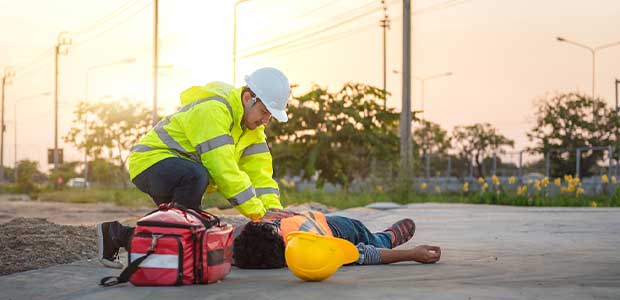
The Dangers of Heat: Different Types of Heat-Related Illnesses
As workers are exposed to heat, they can be at risk for heat-related illnesses.
- By Alex Saurman
- Aug 16, 2022
As the hottest month of the year for many states continues, employers and workers need to take extra caution to protect workers from heat-related illnesses.
There are multiple heat-related illnesses people should watch for when exposed to hot weather or temperatures, the CDC and OSHA say.
Rhabdomyolysis
People can get rhabdomyolysis, or rhadbo, from working in a hot environment. Rhabdo can cause organ damage as well as vomiting, seizures or death, the CDC reports. Symptoms include muscle pain, dark urine or exhaustion. The only way to know if you have rhabdo is to get a blood test. It should be known that rhadbo is rare, with less than 30,000 cases yearly.
Heat Rash
Heat rash often presents itself as bumps on the skin. These can appear on many areas of the body including the neck, chest or in creases. If you or a coworker experience heat rash, make sure to “stay in a cool, dry place,” the CDC says, and don’t get the rash wet. You can also use powders to relieve any discomfort.
Sunburn
People who work in the heat can be at risk for sunburn. This is usually evident through red or warm skin, and in some cases, blisters. When sunburn happens, workers can use cool cloths or lotions to soothe and moisturize the sunburn.
Heat Cramps
A person might have heat cramps if they are sweating a lot or have pain or spasms in the muscles, the CDC says. When a person has heat cramps, hydration and rest are key in recovery. Work should not be resumed until heat cramps have dissipated. People should seek medical attention right away if they experience heat cramps that do not go away after an hour, if they are “on a low-sodium diet” or have a heart issue.
Heat Exhaustion
People may have heat exhaustion if they are thirsty, sweating heavily, are dizzy, have a headache, have a fast, weak pulse, are tired and are nauseous or vomiting, the CDC and OSHA say. When this happens, find a cool place to rest and loosen clothing. Wet cloths or a cool bath can be used to cool the person and the person should drink water. Immediate medical attention is needed if the person is vomiting or if symptoms get worse or do not go away after one hour. Heat exhaustion has the potential to lead to heat stroke.
Heat Stroke
Heat stroke is a serious concern. Some symptoms of heat stroke include heavy sweating, dizziness, a fast, strong pulse, “hot, dry skin,” confusion, slurred speech and fainting. For heat stroke, call 911 right away. It is important to lower the person's body temperature, the CDC says. Move them “to a cooler place” and use cloths or a bath to cool them down. The person should not be given a drink.
It's important to note that heat-related illnesses can be prevented. There are many resources on keeping workers safe from the heat. OSHA has a heat page, a page on heat illness prevention and a heat safety tool. There are also ways workers can protect themselves from heat.
About the Author
Alex Saurman is a former Content Editor for Occupational Health & Safety,who has since joined OH&S’s client services team. She continues to work closely with OH&S’s editorial team and contributes to the magazine.